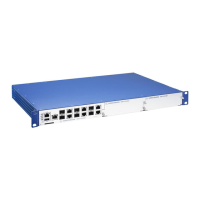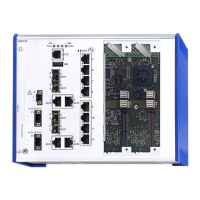Access Control Lists
3-55
3
Configuring an Extended IP ACL
Command Attributes
• Action – An ACL can contain either all permit rules or all deny rules.
(Default: Permit rules)
• Src/Dst IP – Specifies the source or destination IP address. Use “Any” to include
all possible addresses, “Host” to specify a specific host address in the Address
field, or “IP” to specify a range of addresses with the Address and SubMask fields.
(Options: Any, Host, IP; Default: Any)
• Src/Dst Address – Source or destination IP address.
• Src/Dst SubMask – Subnet mask for source or destination address. (See the
description for SubMask on page 3-53.)
• Service Type – Packet priority settings based on the following criteria:
- Precedence – IP precedence level. (Range: 0-7)
- TOS – Type of Service level. (Range: 0-15)
- DSCP – DSCP priority level. (Range: 0-64)
• Protocol – Specifies the protocol type to match as TCP, UDP or Others, where
others indicates a specific protocol number (0-255). (Options: TCP, UDP, Others;
Default: TCP)
• Src/Dst Port – Source/destination port number for the specified protocol type.
(Range: 0-65535)
• Src/Dst Port Bitmask – Decimal number representing the port bits to match.
(Range: 0-65535)
• Control Code – Decimal number (representing a bit string) that specifies flag bits
in byte 14 of the TCP header. (Range: 0-63)
• Control Bitmask – Decimal number representing the code bits to match.
The control bitmask is a decimal number (for an equivalent binary bit mask) that is
applied to the control code. Enter a decimal number, where the equivalent binary
bit “1” means to match a bit and “0” means to ignore a bit. The following bits may
be specified:
-1 (fin) – Finish
- 2 (syn) – Synchronize
- 4 (rst) – Reset
- 8 (psh) – Push
- 16 (ack) – Acknowledgement
- 32 (urg) – Urgent pointer
For example, use the code value and mask below to catch packets with the
following flags set:
- SYN flag valid, use control-code 2, control bitmask 2
- Both SYN and ACK valid, use control-code 18, control bitmask 18
- SYN valid and ACK invalid, use control-code 2, control bitmask 18

